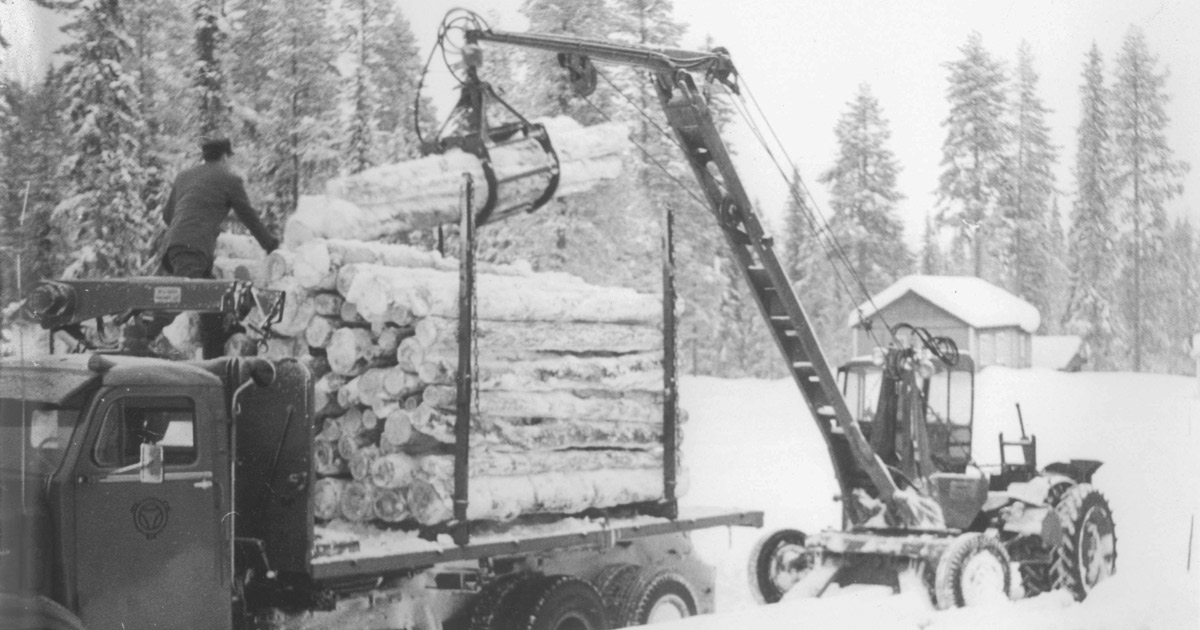ABS-service
Cranab was founded in 1963 by the Jonsson brothers, Rune and Allan. However, the manufacture of cranes had begun earlier when the Jonsson brothers had started producing purpose-built ditching buckets for ABS excavators. In 1959, the Vindeln-based company ABS-service started to manufacture cranes for the forestry industry. The first cranes were very simple. They were comprised of a cylindrical pipe (the boom) that was lifted by a hydraulic tube. At the far end, there was a wire that served as a "capture line" for the timber. Between 1959 and 1960, seven such cranes were produced. In 1961, the cranes were developed so that the boom became foldable. The boom was also equipped with a grapple. However, this lacked a rotator and was controlled by wires. From 1961 to 1962, the company expanded rapidly.
The founding of Cranab AB
In 1963, the small-scale excavator service was brought to an end and it was decided to set up a crane company. Karl-Ragnar Åström bought Rune Jonsson's shares and Cranab AB was formed. The newly formed company continued to expand and, in 1964, the building of a new factory (Cranab 1) began. Completed in the following year, the factory occupied 625 m². Towards the end of the 1960s and at the start of the 1970s, Cranab was growing and developed new models. The SK3000, SK4000, SK5000, SK7000 and SK9000 were amongst these.
Cranab outside Sweden
One year after being founded, Cranab started exporting. The first export, a hydraulic forestry crane with grapple loader, went to Finland. In 1967, the export market expanded outside the Nordic countries to include Yugoslavia and France. During the 1970's, Cranab represented around 85% of the Finnish market. Since then, Cranab has continued to expand and is now one of the world's largest crane and grapple manufacturers.
Timeline
1960 - Manufacture of the first "Vindeln Bear".
1963 - Cranab AB was formed.
1964 - Cranab SK600, the first crane with slewing motor and rotator.
1965 - First factory, Cranab 1, is built.
1966 - First low-profile grapple.
1970 - Cranab SK5000, first OEM delivery for SMW 21.
1972 – Inauguration of the second factory, Cranab 2.
1973 - First deliveries of Cranab cranes with full-circle slewing rotators.
1974 - Cranab AB bought up by Jonsereds. First truck crane produced.
1975 - Cranab begins manufacturing cranes and grapples for feller-buncher machines.
1977 - Production of engine-driven long cranes (10 - 15 m) with patented hose routing begins.
1978 - Cranab AB bought up by HIAB FOCO and manufacture of the first parallel boom crane begins.
1979 - Manufacture of wheel-borne felling head with 15 m reach commences.
1980 - Cranab starts to produce grapple saws and ploughs for clear-felled areas (Savannah ploughs).
1982 - Cranab AB owned 100% by local owners.
1983 - The combi-crane is launched.
1988 - Valmet Logging buys Cranab AB.
1991 - Cranab becomes the Valmet Group's sole crane producer.
1994 - Valmet Logging becomes part of Sisu Corporation.
1996 - Sisu Corporation bought up by Partek Corporation.
1997 - Production of three new truck cranes: 8 tm; 24 tm L type; and 10.5 Z type.
1998 - New off-road programme (forwarder and harvester cranes).
1999 - Cranab AB gains ISO 14001 environmental certification.
2001 - The new CRF series is introduced and replaces the earlier off-road-programme.
2002 - Partek Corporation bought up by KONE.
2004 - Komatsu acquires Valmet Logging.
2005 - Cranab AB bought up by local business leaders, Fredrik Jonsson and Hans Eliasson.
2007 - Slagkraft AB merged with Cranab AB.
2008 - Cranab AB acquires 51% of Vimek AB and Cranab achieves ISO 9001 quality certification.
2011 - New forwarder crane programme, The FC series.
2012 - FC16, Cranab’s biggest forwarder crane is launched.
2013 - Structural deal. Cranab buys Vimek and Bracke Forest. Fassi and Z-forestab become owners.
2015 - Cranab launch the TZ12 road crane.
2016 - Fassi becomes the majority owner of Cranab.
2017 - Fassi acquires full ownership of Cranab.



